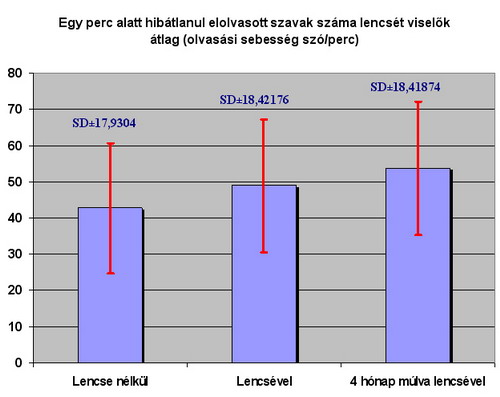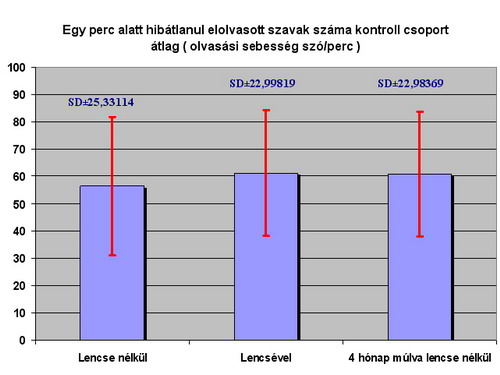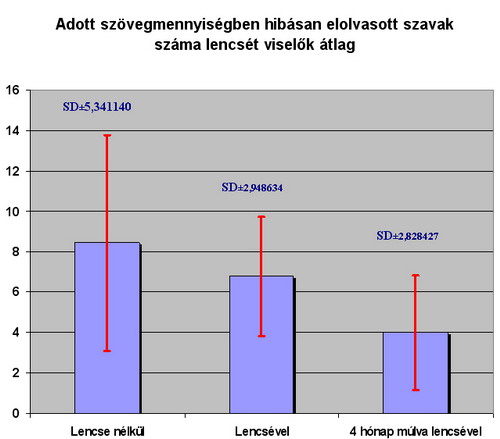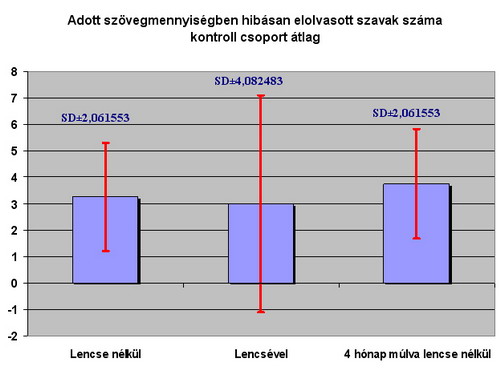How can ChromaGen help?
ChromaGen is a unique system of coloured lenses for DYSLEXIA.
ChromaGen has been clinially proven to dramatically improve accuracy of reading, writing and comprehension.
When the patient selects the right colour combination during the assesment, an immediate improvement can be experienced including clear text, ease of reading and word and number recognition.
ChromaGen is the only patented, US FDA-cleared product for the management of reading disorders throught the fitting of coloured glasses. Clinical trials and numerous studies have demonstrated the benefits of ChromaGen.
The assesment is carried out by an ophthalmologist and an dyslexia expert teacher, and can be carried out on children and adults alike suffering from all forms of ASD /academic skills disorders/ including DYSLEXIA.
Adaption of ChromaGen method to correct dyslexia
Publication of (1) Oculo-Cor Ltd ( managing director dr Ildikó Csobay), (2)Private Tutor Service Foundation,( president of the curatorium:: György Tordai )
dr. Ildikó Csobay(1), Judit Gál (2)
Objective: Assessing the efficiency of ChromaGen colour filter system ( spectacle lenses, contact lenses ) in development of dyslexic patient's reading skills.
Examined patients and method: 450 patients have been examined and corrected with the ChromaGen method. The ChromaGen haploscopic lens system consist of eight type of lenses with special filter characteristics ( 2 pieces of each type). Examinations were carried out according to the ChromaGen protocol, using the evaluation test annexed to the protocol, adapted to the Hungarian language.
Results: Three examinations were carried out. On the first occasion without lenses (1),
on the first occasion with lenses (2), four months later with lenses (3). We measured word readind speed (word/minute, the number of correctly read words per minute), and the number of mistakes on reading a given text.
If we compare the first and the second examination results, reading speed increased significantly ( p= 0,001829), the number of pronounced mistakes decreased , but no significant result could be achieved (p= 0,214459). If we compare the first and the third or the second and third examination results, significant impovement was found in both cases and with both examination methods ( reading speed, pronounced mistakes). ( As for reading speed, comparing the first and the third examination results p= 0,000006, comparing the second and the third examination results p= 0,009590. As for the number of pronounced mistakes, evaluating the results of the first and the third examination p= 0,043606, and evaluating the results of the second and the third examination results p= 0,0182242.
Conclusion: Through the adequate use of ChromaGen haploscopic lens system, significant progress can be achieved with large part of dyslexic patients in the development of reading skills.
Key words: dyslexia, ChromaGen system, synchronization
Experts dealing with investigating the Academic Skills Disorders have long known that dyslexia can be caused by a lot of different factors. Teachers together with primary school pupils have been fighting a heroic battle to try and find an alternative method for acquiring reading skills.
In the last decade more and more physicians started looking into the problem to find out whether the representatives of certain areas of medicine (ear and throat doctors, otolaryngologits, opthamologists, neurologists, psychiatrists, immunologists and diatetics) can help to ease the problem of dyslexia.
Looking over the scientific publications of this short period we can claim that the above experts have done a lot to improve the situation and with the assistance of the special reeducational programs of experts on dyslexia, they can raise the chance of patients with dyslexia to acquire reading, writing and spelling skills with a fairly good result.
The present results are supposed to be partial results. In each field the reasearch has been on progress and it is hoped that more and more efficient corrective methods will be supplemented to the mine of experts dealing with Academic Skills Disorders .
In the present publication we are aiming to give account of the results obtained in the territory of opthamology.
It was Olive Meares , a teacher in New Zealand who described the first symptoms: when reading the text, it becomes distorted in a way , this distortion can be reduced with the help of coloured sheets.11
Based on the first experiments of Olive Meares, Helen Irlen , a psychologist from California started the first scientific clinical researches. Later this syndrome was named Meares- Irlen Syndrome by experts. 2,9,14,15
In 1989 Arnold Wilkins, the professor of University of Essex and his team began their first
examinations with the help of their instruments developed by themselves. This was called the Intuitive Colorimeter, with the help of which the filter lens that improves reading the most was determined. They already used spectacle lenses. 19,20
In 1999 David Harris, the professor of Ultralease, The Chester Clinic published his successful placebo controlled double blind examination with reference to the dyslexia corrective efficiency of the ChromaGen filter system which had been invented by himself.
Later on other filter systems were put on the market, but clinically proved examination results have only been issued by applying these two methods. According to clinically comparative examinations made, using the Chroma Gen method the results achieved were significantly better , than those with the Intuitive Colorimeters method.5,6,7,8
Patients and the method
We have examined and corrected 562 patients with the ChromaGen method. Out of the examined apatients 450 have ordered the ChromaGen filter, 180 women, 270 men, average age was 12,75 (SDą 4,17). All the people who had applied for the exam were involved, irrespective of age or sex., provided, that they met the examination conditions.Each patient was expected to prove their partial disorder by a certificate. Patients had no non correctable refractional, ortoptical or other opthamological problems that would hinder reading anyway.
A group of previously examined, 50 patients(27 men, 23 women, average age 11,75 years (SDą 1,26)) who did not wish to order the filters were used as a controll group for testing the improvement of their reading skills within the four months interval.
Examinations were carried out with the help of the ChromaGen haploscopic lens system (the two eyes are examined together and separately as well) . The lens system consists of eight type of lenses with special filter characteristics. ( 2 pieces of each type ). The examinations were carried out according to the ChromaGen protocol. (1.picture)
To measure the efficiency of the lenses and the improvement of reading skills we applied
Prof. Chaaban Zeidan s Academic Skills Disorders Appraisal Test adapted to the Hungarian language, which was validated by the English wholesailer. (Cantor and Nissel Ltd.)
Dyslexia correction was in every case preceded by an opthamological examination...All the opthamological problems were eliminated or corrected.
Examinations were carried out in natural lighting according to Chroma Gen protocol.
The dominant eye then was determined. Firts we picked the right filter for the non-dominant eye, so that the patient was looking at the given text having both eyes open. The task for the patient was to choose the filter which was the most comfortable one to look through, the one, which relaxes the eye most, and with the help of which reading was the most efficient.
Then, keeping the chosen filter in front of the non-dominant eye, we determined the adequate filter for the dominant eye. (2. picture) In a lot of cases the two filters were not of the same characteristics (colour),which might mean an aesthetic problem, but this problem can be eliminated by ordering the lenses with a mirror coating. Only after determining the filters could we start testing the efficiency with the test mentioned before.After a little break the patients were to accomplish the test under the supervision of our expert on dyslexia, first without using the filter, then following a little break again the patients repeated the test with using the filters. Examinations were repeatedly carried out four months after the patient had started to use the glasses.
Word reading speed was measured, that is the correctly read words per minute, than also the number of mistakes made when reading a given text. (The difficulty of the text to read varies according to age groups.)
Results
Three examinations were carried out: 1.: First time without filter, 2.:first time with filter , 3.: four months after the patients had started using the filtered glasses. In the case of the controll group we did not use filter on the occasion of the 3. examination.
If we compare the data of the first and the second examinations, based upon the results of the examinations, word reading speed significantly improved. (p= 0,001829) / Student T-test/
Comparing the results of the first and the third examination, the word reading speed further improved (p=0,000006). Comparing the data of the second and the third examinations we again managed to register a significant improvement in word reading speed ( p=: 0,009590).
/1. table, 1. figure/
In the case of the control group the average word reading speed was higher.This can be explained by the fact that those people had originally had less problems .
When comparing the results of the first and second examinations the word reading speed
improved significantly in those cases as well., which means that the filters proved to be efficient in their cases as well (p=0,032005)..
According the results of the first and third examinations (here without lenses) the reading speed also improved , but in a much smaller extent than with those patients who were wearing the lenses. No significancy could be proved. (p=0,311163).
But then again, when we compared the results of the second (firts time with lenses) and the third(four months later without lenses) examinations we realized that the second reading speed was higher that the third one (p=0,872889). / 2. table, 2.figure /
The conclusion is that the control group also improved, but not in such an extent as those who were wearing the lenses. What is more, in comparison their reading with lenses for the first time ( 2. examination) with their reading for the third time without lenses ( 3. examination) their word reading seed stayed lower even after 4 month.
When comparing the results of the first and the second examinations in view of the number of mistakes made in a given text, we can realize that the number of mistakes made, decreased but not in significant degree (p=0,214459). If we compare the results of the first and the third examinations,
the number of mistakes made significantly decreased (p=0,043606), and we also experienced a significant decrease in the number of mistakes made if we compare the data of the second and third examination (p=0,018242). /3.table 3. figure /
If we compare the results of the first and second examinations in view of the data of the control group we will realize that the number of mistakes decreased but not significantly (p=0,677672).
Considering the first and the third examinations, the number of mistakes was higher in the case of the third examination than in the case of the first one (p=0,637618). We can find similar results if we compare the data of the second and that of the third examination. In the case of the third examination
the number of mistakes was higher than with the second examination (p=0,748707). /4. table, 4. figure /
On the first occasion ( comparison of the first and the second examinations) when we compared the number of mistakes made both in the case of patients, having glasses, and that of the control group ( In this case the control group as it is, has no informatic value, becouse for the first occasion,
with the second examination everybody was using lenses.) most propably the number of mistakes made did not decrease more significantly becouse the vision system of the patient or the superior neurological centres playing a role in the reading process got in an entirely new situation, the immediately
increased reading speed could not be caught up with by the improvement of reading skills.
It is also thought-provoking that when we compared the results of the first and the third examination why the number of the mistakes increased with the control group in the case of the third examination, when would have expected the number of mistakes to decrease with the increase of reading speed,
in spite of the fact, that these patients did not wear filters.
This canbe explained by the fact, that the reading skills could not catch up with the development of the reading speed. The efficiency of the filtered lenses is reinforced by comparing the results of the second and third examinations, that is the less mistakes were made by the patients belonging
to the control group, when they were reading with the help of the filtered lenses for the first occasion ( 2. examination).
The value of the standard deviation is effected by the fact, that the data have not been broken down according to age groups. In spite of the above , there has been high significancy. It is expected, that when studying new data and breaking them down according age groups ,together with the increase in significancy we can register a decrease in standard deviancy.
Discussion
Most experts dealing with dyslexia would agree on the fact, that dyslexia is a langauge coding disorder. It is also indisputable, that the basic condition of reading and writing is the perfect operation of the hearing and vision functions, that is the perceiving, transmitting and processing of
the sound and light stimuli changing in the time and space.
With patients fighting with reading and writing difficulties , have normaly no problem with coding of sound and light stimuli changing in the space ( space frequencies).
On the other hand more critical is the situation in the case of perceiving, transmitting and processing of sound and light stimuli changing in the time ( temporal fraquencies), in addition to the coordination of responses, movements reflecting to these stimuli.10
It is the magnocellular system of the central nervous system that is responsible for the coordination of the coding sound and light stimuli changing in time and for responses ( movements) given to these.
The magnocellular cells are the biggest cells of the central nervous system. The system of track created by them is called magnocellular system.
To sum up all above, one of the most frequent cause of dyslexia is the deficiency of the magnocellular system.
The decrease of sensibility for changing of frequency and amplitudo of sounds, the defective hearing system is folloved by the decrease of phonological abilities and also decreased the sensibility for dinamic visual stimuli.
In most cases the defectiveness of the magnocellular system can be detected in all of areas at the same time.
The basic symptoms ( problems of hearing, seeing, coordinating the movements) are determined by the fact that wich part of the magnocellulat system is the most impaired area. In most cases each area , connected with the operation of the magnocellular system is concerned at a certain stage.3,4
Based on the above it is evident that the visual system is effected by this process in almost every case in a smaller or bigger degree. Starting from the retina two different systems of nerve cells can be found on the visual pathway. The magnocellular and the parvocellular systems The magnocellular
cells are approximately ten times bigger then the parvocellular ones. The parvocellular cells are responsible for transmitting the slow, high contrast informations ( colours, parts of pictures, stills) / space frequencies/, while the magnocellular cells are responsible for transmitting the fast,
low contrast informations ( sense of movement, depth vision, recognizing the position of objects)/ temporal frequencies/.
To sum it up, the parvocellular system perceives WHAT we can see and the magnocellular system perceives WHERE we can see the given object.
The basic condition of reading ability is that the two systems should work in a syncronous way.
In the case of dyslexia the transmitting speed of the magnocellular cells has decreased therefore at certain areas overstimulation come into being. (Becouse the stimuli pile up on the concerned nerve cells.) Thus it is understandable that on the rest parts of the visual pathway the stimulus goes
on an irregular way. Considering all these it is not suprising that the irregular stimulus results in an irregular response, that is the moving nerves of the two eyes are given irregular , inadequat innervation.
This results in a situation, that the two eyes start wandering around the point to fix at independently from each other. The fusion and vergency are hindered, and as a result , missing of the lines, changing of letters, and other reading mistakes can occur.1,16,17 Naturally, these are all mini symptoms, sometimes are impossible to prove with the help of traditional examining methods. To prove them we need special tests and examination methods.1,20,21
Effect of the coloured filters
On one side they have a general effect, which is based on the fact that when reading, one of the basic stimulus is the light. With the help of the filters we change the spectral composition of the light, that is we filter certain wave lenghts from the white light, and this results in a different
basic stimulus for the nervous system, which is easier to comprehend for the sometimes less developed nervous system of dyslexic patients.
On the other side, they also have a direct effect on the visual pathway, that is, they slow down the speed of information proceeding on the visual pathway, insomuch as the slowly conducting magnocellular cells are able to conduct them. This results the elimination of the overstimulation on the
sensory part of the visual pathway and thus on the motoric part of the visual pathway the moving muscles of the two eyes get an adequat,synchronized stimulation. These are followed by a significant improvement of reading abilities.
If the magmocellular damage is more signifiant in the visual system, a promt , spectacular effect can be achieved with coloured filters, but if the magnocellular damage is more significant in the auditory system, the improvement will only occure later, gradually, for in this case only the general
effect of the coloured filters can be utilized.5,6,7,19
Conclusion
Dyslexia is a very complex problem. The method of an efficient therapy is the complex therapy of dyslexia. On a general basis, the patients first meet the experts on dyslexia , who evaluates the langauge abilities and conduct an adequate reeducational program for them. But this is not enough.
The patients should undergo an overall checkup, and based on the medical consultation of experts ( ophthalmologist, phoniatrists, neurologists, and others if needed) they should be treatet accordingly, and additional treatments should be used to make the therapy complex.
One of the efficient additional methods is the uses of coloured lenses.
To sum up the most efficient method of correction of dyslexia is the reeducation adapted to the special needs of the individual, supported by the special medical therapies also adapted to the special needs of the individual.
Referencies
1. Cornelissen P.L., Hansen P.C., Hutton J.L. et al.: Magnocellular visual function and children's single word reading. Vision Res 1998; 88: 471-482.
2. Evans B.J.W., Wilkins A.J., Brown J. et al.: A preliminary investigation into the aetiology of Meares-Irlen syndrome. Ophthalmol Physiol Opt 1996; 16: 289-96.
3. Galaburda A.M., Sherman G.F., Rosen G.D. et al.: Developmental dyslexia: four consecutive patients with cortical anomalies. Ann Neurol 1985; 18: 222-33.
4. Galaburda A.M., Aboitiz F.: Biological foundations of dyslexia. A rew Arc Biol Exp /Santiago/ 1986; 19: 57-65.
5. Harris D.A.: Colouring sight: A Study of CL tiltings with colour- enhancing lenses. Optician 1997; 213: 38-41.
6. Harris D.A., MacRowe-Hill S.J.: Interim report on he use of ChromaGen contact lenses in patients with specific learning difficulties. Optometry Today /UK/ 1998; 38: 24-5.
7. Harris D.A., Susan J., MacRowe-Hill S.J.: Application of ChromaGen haploscopic lenses to patients with dyslexia: a double-masked, placebo-controlled trial. J Am Optom Assoc 1999; 7O: 629-64O.
8. Hodd N., Burnett : Putting ChromaGen to the test. Optimetry Today /UK/ 1998; 38: 39-42.
9. Irlen H.: Reading by the coloures: overcoming dyslexia and other reading disabilities through the Irlen method. New York: Avery Publishing Group, 1991.
10. Livingstone M.S., Rosen G.D., Drislane F.W. et al.:Physiological and anatomical evidence for magmocellular defect in developmental dyslexia. Proc Nat Acad Sci USA 1991;, 1993; 88: 7943-7.
11. Meares O.; Figure/ground, brightness contrast, and reading disabilities. Visible Language 198O; 1: 13-29.
12. Rae C., Lee M.A., Dixon R.M., et al.: Metabolic abnormalities in developmental dyslexia detected by IH magnetic resonance spectroscopy. Lancet 1998; 351: 1849-52.
13. Schrott L.M., Denenberg V.H., ShermannG.F. et al.: Environmental enrichment, neocortical ectopias, and behavior int he autoimmun NZB mouse. Brain Res Dev 1992; 67: 85-93.
14. Solan H.A.: An appraisal of the Irlen technique of correcting reading disorders using tinted overlays and tinted lenses. J. Learn. Disabil. 199O; 23: 613-626.
15. Solan H.A., Richman J.: Irlen lenses: a critical appraisal. J Am Optom Assoc 1992; 61: 789-96.
16. Stein J.F.: Developmental dyslexia , neural timing, and hemispheric lateralisation. Int J Psychophysiol 1994; 18: 241-9.
17. Stein J.F.,Walsh V.: See but not to read: the magnocellular theory of dyslexia Trends Neurosci 1997; 2O: 147-52
18. Waters N.S., Sherman G.F., Galaburda A.M. et al.: Effects of cortical ectopias on spacial delayed- matching-to-sample performance in BXSB mice. Behav Brain Res 1997; 84: 23-29.
19. Wilkins A.J., Evans B.J.W., Brown J.A. et al.: Double-masked placebo-controlled trial of precision spectral filter sin children who use coloured overlays. Ophthalmol Physiol Opt 1994; 14: 365-37O.
20. Wilkins A.J., Jeanes R.J., Pumfrey P.D. et al.: Rate of Reading Test: its reliability and validity in the assessment of the effects of coloured overlays. Ophthalmol Physiol Opt 1996; 16: 491-7.
21. Zeidan C.: Academic Skill Disorders Programme. www. zeidan.co.uk
Address of authors: dr. Ildikó Csobay
Oculo-Cor Ltd.
Budapest,
Tőke u. 13.
1223
Hungary
E-mail: oculocor @t-online.hu
1. Table
Data of how average (standard deviation /?SD/) word reading speed ( word/minute) changed with all the patients wearing coloured glasses. The results of the first, second and third examinations.
1. without lenses |
2. with lenses |
3. 4 months later with lenses |
42,67 (SD ?17,9304) |
48,89 (SD ?18,42176) |
53,67 (SD ?18,41874) |
2. Table
Data of how average ( standard deviation /?SD/) word reading speed ( word/minute) changes with the control group based on hte first, second and third examinations.
1. without lenses |
2. with lenses |
3. 4 months later without lenses |
56,50 (SD ?25,33114) |
61,25 (SD ?22,99819) |
60,75 (SD ?22,98369) |
3. Table
Data of the changes in the average(standard deviation / ?SD/) number of mistakes with all patients wearing coloured glasses, based on the results of the first, second and third examinations.
1. without lenses |
2. with lenses |
3. 4 months later with lenses |
8,44 (SD ?5,341140) |
6,78 (SD ?2,948634) |
4,00 (SD ?2,828427) |
4. Table
Data of the changes in average (standard deviation /?SD/) number of mistakes with the control group, based ont he first,second and third examinations.
1. without lenses |
2. with lenses |
3. 4 months later without lenses |
3,25 (SD ?2,061553) |
3,00 (SD ?4,082483) |
3,75 (SD ?2,061553) |
1 Figure
Grafic illustration of average word reading speed (word/ minute) changes with patients wearing coloured glasses based on the results of the first ,second and third examinations

without lenses with lenses 4 month later with lenses
2 FigureGrafic illustration of how average word reading speed (word/minute) changes with the control group based on the first, second and third examinations

without lenses with lenses 4 month later without lenses
3 Figure
Grafic illustration of the changes in the average number of mistakes based on the first, second and third examinations

without lenses with lenses 4 month later with lenses
4 FigureGrafic illustration of the changes in the average number of mistakes with the control group, based on the results of the first, second and third examinations

without lenses with lenses 4 months later without lenses
